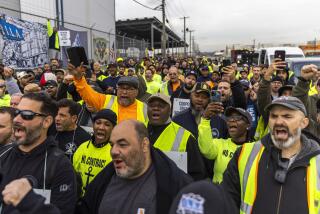Ships lining up at drive-to-pier ports
- Share via
IT’S not exactly the most exciting itinerary: The ship sails down the East Coast for nearly two days to reach its first stop -- Port Canaveral in central Florida -- moves on to Miami for a night, and then visits the Bahamas and a private island before sailing back up the coast to where it began.
Despite the itinerary -- or perhaps because of it -- the new vessel, the Norwegian Dawn, is a hit among cruisers. The reason? It sails round-trip from a huge population center, New York, enabling its passengers to drive their cars to the pier. The weekly sailings are constantly filled. And Carnival Cruises has announced that it will shortly imitate this year-round, weekly New York-to-New York pattern with its own Carnival Miracle.
I call it drive-to-the-pier cruising, and it’s taking off all over America: from San Diego, San Francisco, Los Angeles, Seattle and Galveston, Texas, to New Orleans and Norfolk, Va., to Philadelphia and Baltimore. More cruise lines are placing their ships year-round in new cruise ports. Passengers don’t need to incur the cost (often about $1,200 for a family of four) and stress of a round-trip flight to reach the place from which the ship departs and to which it returns.
The trend is based not so much on fear of flying as on dread of airports. Many people dislike the hassle of passing through security, taking off shoes and wristwatches and lugging their baggage to an explosives detector. Still more are happy to avoid the expense of adding airfare to the cost of the cruise. Thus, even in winter, thousands are boarding a ship in frigid New York and embarking on what might be called a seven-night “cruise to nowhere.”
From the West Coast, the craving for drive-to-the-pier cruises has caused Holland America Cruises to place two and sometimes three additional ships in San Diego for southbound sails to Mexican ports such as Loreto, La Paz and Cabo San Lucas. From San Francisco, Celebrity Cruises operates its Mercury on cruises to Monterey, Calif., and Ensenada, Mexico.
From the Los Angeles-Long Beach area, more ships are bound for different ports. Princess Cruises and Holland America are scheduling 15- and 16-night cruises that sail round-trip to Hawaii (stopping in Ensenada, Mexico, on the return leg to satisfy legal requirements).
Pat Webb and his GalaxSea Cruises and Tours, (800) 662-5450, www.cruisestar.com is among sources for seagoing bargains departing from drive-to-the-pier locations in California and Seattle (embarkation point for many Alaskan cruises). Other popular U.S. drive-to-the-pier ports include Galveston, Texas (home port of cruise ships for several years); Jacksonville in northern Florida; Baltimore; Charleston, S.C.; New Orleans; and Philadelphia, a favorite embarkation point for many Bermuda cruises.
Cruise broker Rick White, who serves many Midwestern clients, reports that St. Louis and Chicago residents often drive south to ports in Galveston and New Orleans because they’re closer than South Florida. His agency, White Travel Service in West Hartford, Conn., (800) 547-4790, sells seven-day cruises from Galveston and New Orleans (without accompanying airfare) for as little as $599 (prices fluctuate, depending on the date), with upgrades to outside cabins for $150 more.
What does the future hold for drive-to-the-pier cruising?
Would you believe Bayonne, N.J.? So strong is the demand for boarding cruise ships without flying first that Royal Caribbean Cruises is constructing a new passenger terminal in that area of industrial blight and will begin operating alternating nine-night (Caribbean) and five-night (eastern Canada) cruises from there on its 140,000-ton Voyager of the Seas, starting May 21. It’s expected to be popular among Northeastern families and seniors.
More to Read
Sign up for The Wild
We’ll help you find the best places to hike, bike and run, as well as the perfect silent spots for meditation and yoga.
You may occasionally receive promotional content from the Los Angeles Times.






